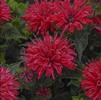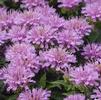Plant Information Resource Center
A Service Provided by Bohn's Farm and Greenhouses
Matteuccia struthiopterisFern, Ostrich
One of the largest and most popular perennial ferns. Dark green fronds are shaped like ostrich plumes. Clump forming, upright to arching habit. Rapid spreader requiring space to grow. Good ground cover that spreads rapidly in moist areas.
[
More Info
]
|

|
Mazus reptansMazus, Creeping
Low growing ground cover with bright green foliage forms a dense mat. Tiny lavender-blue flowers appear in small clusters April and May. May repeat bloom in September. Creeping stems root at nodes.
[
More Info
]
|

|
Mertensia virginicaBluebells, Virginia
Flowers are pink in bud and open to sky blue in March and April. Foliage is blue-green. This plant is a spring ephemeral, meaning the foliage goes dormant in summer. A great plant to naturalize in a rich, moist, woodland environment.
[
More Info
]
|

|
Mimulus ringensMonkey Flower, Allegehny
Lilac-purple snapdragon-like flowers appear in pairs June through September. Upright foliage is bright green. Native to swampy areas, wet meadows and low woods. Spreads by creeping rhizomes.
[
More Info
]
|

|
Miscanthus sinensisGrass, Flame
[
More Info
]
|

|
Miscanthus sinensis 'Adagio'Grass, Maiden
[
More Info
]
|

|
Miscanthus sinensis 'Cabaret'Grass, Maiden
Super-bold variegation is the highlight of Cabaret Miscanthus. Each 1.25-inch- wide leaf is marked with deep green borders and a white center, the opposite variegation of its kissing cousin, Cosmopolitan Miscanthus. Because of the lively coloring and eight-foot height, Miscanthus sinensis var. condensatus 'Cabaret' makes an impressive specimen that is well worth the space it needs in the landscape. In early fall, pink blooms rise one foot above foliage for an impressive fall display. Cabaret Miscanthus was introduced in the mid-70s by the US National Arboretum.
[
More Info
]
|

|
Miscanthus sinensis 'Dixieland'Grass, Dwarf Maiden
[
More Info
]
|

|
Miscanthus sinensis 'Gracillimus'Grass, Maiden
[
More Info
]
|

|
Miscanthus sinensis 'Little Kitten'Grass, Dwarf Maiden
[
More Info
]
|

|
Miscanthus sinensis 'Little Zebra'Grass, Dwarf Zebra
Green leaves with bright yellow horizontal bands. Red-purple flower plumes appear in August. A compact selection of M. `Zebrinus. Attracts songbirds. PPAF
[
More Info
]
|

|
Miscanthus sinensis 'Morning Light'Grass, Maiden
[
More Info
]
|

|
Miscanthus sinensis 'Strictus'Grass, Porcupine
[
More Info
]
|

|
Miscanthus sinensis 'Variegatus'Grass, Variegated Japanese Silver
Green and white striped leaves are 1/4 - 3/4" wide and arch loosely. Provides a strong white effect in the landscape. Flowers in August or September. Plants may require support to remain upright.
[
More Info
]
|

|
Monarda bradburyanaBergamot, Wild
[
More Info
]
|

|
Monarda fistulosaBergamot, Wild
Spidery pompons of lavender blossoms are irresistible to butterflies and hummingbirds, and the fragrant gray-green foliage is wonderful in a scent garden or herb garden. Provide good air circulation to minimize powdery mildew, and deadhead to prolong flowering.
[
More Info
]
|

|
Monarda x didyma 'Blue Moon'Bee Balm
Lavender blue flowers are held by attractive purple bracts.A breakthrough, shorter height for this color.The members of the SUGAR BUZZ® Series from the Walters Gardens, Inc. hybridizing program are perfectly suited to the middle of the flower border at 16-24" tall. All members in this series are similar in size, bloom time, and vigor, making it easy for growers to offer the entire series. In midsummer, they form a solid dome of color with their 2-2.5" flowers on strong, well-branched stems. The dark green foliage forms an upright clump with enough vigor to quickly fill out containers nicely but are not aggressive in the garden. As with all Monardas from the Walters Gardens, Inc. hybridizing program, these display above average resistance to powdery mildew.
[
More Info
]
|

|
Monarda x didyma 'Bubblegum Blast'Bee Balm
This brand new series of SUGAR BUZZ™ Monardas is perfectly suited to the middle of the flower border. All four unique colors in this series are similar in size, bloom time, and vigor, making it easy for growers to offer the whole lot.
In midsummer, 'Bubblegum Blast' forms a solid dome of hot pink, 2-2.5” flowers on strong, well-branched stems. The dark green foliage forms an upright clump that will fill out containers nicely but won’t run all over the garden. It displays above average resistance to powdery mildew.
[
More Info
]
|

|
Monarda x didyma 'Cherry Pops'Bee Balm
This brand new series of SUGAR BUZZ™ Monardas is perfectly suited to the middle of the flower border. All four unique colors in this series are similar in size, bloom time, and vigor, making it easy for growers to offer the whole lot.
In midsummer, 'Cherry Pops' forms a solid dome of cherry red, 2-2.5” flowers on strong, well-branched stems. The dark green foliage forms an upright clump that will fill out containers nicely but won’t run all over the garden. It displays above average resistance to powdery mildew.
Monarda is native to eastern North America, so it is easy to grow and it multiplies quickly. The flowers' sweet nectar attracts scores of hummingbirds, butterflies, and bees to the garden. The aromatic foliage smells like mint when crushed and is often used to flavor teas.
[
More Info
]
|

|
Monarda x didyma 'Grape Gumball'Bee Balm
This brand new series of SUGAR BUZZ™ Monardas is perfectly suited to the middle of the flower border. All four unique colors in this series are similar in size, bloom time, and vigor, making it easy for growers to offer the whole lot.
In midsummer, 'Grape Gumball' forms a solid dome of vibrant magenta, 2-2.5” flowers on strong, well-branched stems. The dark green foliage forms an upright clump that will fill out containers nicely but won’t run all over the garden. It displays above average resistance to powdery mildew.
Monarda is native to eastern North America, so it is easy to grow and it multiplies quickly. The flowers' sweet nectar attracts scores of hummingbirds, butterflies, and bees to the garden. The aromatic foliage smells like mint when crushed and is often used to flavor teas.
[
More Info
]
|

|
Monarda x didyma 'Jacob Cline'Bee Balm
Large bright red flower clusters appear July through September. Upright, mildew resistant, fragrant foliage can be used to flavor tea. Attracts hummingbirds.
[
More Info
]
|

|
Monarda x didyma 'Leading Lady Lilac'Bee Balm
PROVEN WINNER. Bee Balm typically bloom in midsummer, but ‘Leading Lady Lilac’ leads the way in early summer, flowering earlier and forming a more petite clump than other Bee Balm (like ‘Pardon My Purple’). She typically blooms from early summer (first week of June in Michigan) into midsummer and grows just a foot tall.
Her densely branched, dark green, somewhat glossy foliage is topped with light lilac purple blossoms coddled by purple bracts. A fine mist of dark purple spots appears on the open petals. After the first flush of flowers is passing full bloom, a secondary flush blooms above the initial flowers, extending the color show into midsummer.
‘Leading Lady Lilac’ behaves like a lady in the garden—she stays where you plant her and doesn’t run around. Her blossoms’ sweet nectar is highly attractive to butterflies, hummingbirds, and honeybees and her aromatic foliage is naturally deer resistant.
[
More Info
]
|

|
Monarda x didyma 'Leading Lady Plum'Bee Balm
PROVEN WINNER. Bee Balm typically bloom in midsummer, but ‘Leading Lady Plum’ leads the way in early summer, flowering earlier and forming a more petite clump than other Bee Balm (like ‘Pardon My Purple’). She typically blooms from early summer into midsummer and grows just a foot tall.
Her densely branched, dark green, somewhat glossy foliage is topped with magenta purple blossoms coddled by deep blackish purple bracts. A fine mist of dark purple spots appears on the open petals. After the first flush of flowers is passing full bloom, a secondary flush blooms above the initial flowers, extending the color show into midsummer.
‘Leading Lady Plum’ behaves like a lady in the garden—she stays where you plant her and doesn’t run around. Her blossoms’ sweet nectar is highly attractive to butterflies, hummingbirds, and honeybees and her aromatic foliage is naturally deer resistant.
[
More Info
]
|

|
Monarda x didyma 'Pardon My Cerise'Bee Balm
PROVEN WINNER. No room for the tall, bushy, traditional Bee Balm in your garden? Here is a petite selection that’s easy to tuck into the front of your sunny border and combination containers. Reaching just a little over a foot tall at maturity, this compact selection forms a bushy, well-branched clump of green, semi-glossy foliage.
From mid through late summer, dark cherry pink flowers sit just at the top of the foliage. Though the plant may be dwarf, the flowers are the same size as taller selections, measuring a full 2 ½ - 3 inches across. They add a bright splash of color to the border in high summer.
This new selection also offers good resistance to powdery mildew, a problem with many older Bee Balms. Just provide good air circulation, sunshine, and plenty of water and these plants will thrive!
[
More Info
]
|

|
Monarda x didyma 'Pardon My Lavender'Bee Balm
PROVEN WINNER. No room for the tall, bushy, traditional Bee Balm in your garden? Here is a petite selection that’s easy to tuck into the front of your sunny border and combination containers. Reaching just a little over a foot tall at maturity, this compact selection forms a bushy, well-branched clump of medium green, semi-glossy foliage. Slightly running, but controlled and refined habit.
From mid through late summer, light lavender pink flowers sit just at the top of the foliage. The insides of the flowers are lighter pink, giving the flower a three-dimensional look. Though the plant may be dwarf, the flowers are the same size as taller selections, measuring a full 2 ½ - 3 inches across. They add a bright splash of color to the border in high summer.
This new selection also offers good resistance to powdery mildew, a problem with many older Bee Balms. Just provide good air circulation, sunshine, and plenty of water and these plants will thrive!
[
More Info
]
|

|
Monarda x didyma 'Pardon My Purple'Bee Balm
No room for the tall, bushy, traditional Bee Balm in your garden? Now there’s a petite selection that’s easy to tuck into the front of your sunny border and combination containers. Reaching just a foot tall at maturity, this compact selection forms a well-branched clump of deep green, glossy foliage.
From mid through late summer, fuchsia purple flowers sit just at the top of the foliage. Though the plant may be dwarf, the flowers are the same size as taller selections, measuring a full 2 ½ - 3 inches across. They add a cool splash of color to the border in high summer.
This new selection also offers good resistance to powdery mildew, a problem with many older Bee Balms. Just provide good air circulation, sunshine, and plenty of water and these plants will thrive!
[
More Info
]
|

|
Monarda x didyma 'Pink Frosting'Bee Balm
The members of the SUGAR BUZZ® Series from the Walters Gardens, Inc. hybridizing program are perfectly suited to the middle of the flower border at 16-24" tall. All members in this series are similar in size, bloom time, and vigor, making it easy for growers to offer the entire series. In midsummer, they form a solid dome of color with their 2-2.5" flowers on strong, well-branched stems. The dark green foliage forms an upright clump with enough vigor to quickly fill out containers nicely but are not aggressive in the garden. As with all Monardas from the Walters Gardens, Inc. hybridizing program, these display above average resistance to powdery mildew.
Pastel pink flowers form a carpet of blossoms that completely cover the foliage.
[
More Info
]
|

|
Monarda x didyma 'Rockin Raspberry'Bee Balm
Deep raspberry purple flowers with very dark green leaves. The members of the SUGAR BUZZ™ Series from the Walters Gardens, Inc. hybridizing program are perfectly suited to the middle of the flower border at 16-24” tall. All members in this series are similar in size, bloom time, and vigor, making it easy for growers to offer the whole lot. In midsummer, they form a solid dome of color with their 2-2.5” flowers on strong, well-branched stems. The dark green foliage forms an upright clump that will fill out containers nicely but won’t run all over the garden. As with all Monardas from the Walters Gardens, Inc. hybridizing program, these display above average resistance to powdery mildew.
[
More Info
]
|

|
Nepeta 'Early Bird'The earliest blooming Nepeta we've had in our trials, with flowers starting in early April and lasting up to six weeks! Clean, gray-green, aromatic foliage and a compact habit make it an excellent groundcover. A low-growing member of the clan whose aromatic, gray-green leaves complement the lavender-blue blossoms. Its flowers gather in whorls on stems that reach just 12", and bloom is persistent up to six weeks. This compact, early-blooming variety makes an excellent ground cover for edging a sunny walkway.
Most Nepetas are thrifty plants that prosper in average, well-drained soils, and the majority offer deliciously fragrant, gray-green foliage and numerous spikes of small flowers, generally in the blue to purple range. They are durable, hardy, and pest free. Like Catnip, the best-known member of the genus, Nepetas may send felines into a frenzy.
[
More Info
]
|

|
Nepeta faassenii 'Purrsian Blue'Catmint
In its first year, 'Purrsian Blue' forms a small, perfectly rounded, densely branched clump of tiny, green leaves. In year two, the plant maintains its compact mounding habit but nearly doubles its spread to just over two feet across.
This is a very floriferous selection whose flower power is amplified by its having its flowers spaced closely together on the stems. Periwinkle blue flowers are coddled by dark purple calyxes just above the aromatic foliage from early summer into early fall.
'Purrisan Blue' has everything today's gardeners are looking for: a low maintenance, drought tolerant, deer resistant, long blooming perennial that looks great all season.
When Nepeta's stems are broken, they release an aroma into the air that tends to attract cats, thus its common name, Catmint.
[
More Info
]
|

|
Nepeta x faassenii 'Blue Wonder'Catmint
Long-blooming, dark blue flowers May through September. Compact, mounding, gray-green, aromatic foliage. Quite drought tolerant. Much more compact than Nepeta `Walkers Low. A wonderful low maintenance perennial for drought prone landscapes.
[
More Info
]
|

|
Nepeta x faassenii 'Cat's Meow'Catmint
Unlike most Nepetas that have a bit of a wild, unkempt look, this first class selection keeps its tidy, dense, rounded shape all season long.
Its small, grey-green, aromatic leaves are topped with well-branched stems carrying spikes of sky blue flowers with purple calyxes from early summer into early fall.
‘Cat’s Meow’ has everything today’s gardeners are looking for: a low maintenance, drought tolerant, deer resistant, long blooming perennial that looks great all season.
When Nepeta's stems are broken, they release an aroma into the air that tends to attract cats, thus its common name, Catmint.
[
More Info
]
|

|
Nepeta x faassenii 'Six Hills Giant'Catmint
Violet blue flowers on large plants with gray-green foliage.
[
More Info
]
|

|
Nepeta x faassenii 'Walker's Low'Catmint
Soft lavender-blue flowers bloom May through September on mounded, arching plants. Aromatic gray-green foliage is deer and rabbit resistant. Very drought tolerant. Cats are attracted to scent. [PPA-2007]
[
More Info
]
|

|
Oenothera berlandieri 'Siskiyou'Primrose, Mexican Evening
Pale pink, saucer-shaped flowers are produced in great numbers May through July with rebloom in the fall. Compact and trailing habit. Heat and drought tolerant. Prefers poor soils. Spread by underground stolons.
[
More Info
]
|

|
Oenothera macrocarpa (syn missouriensis)Sundrops, Ozark
Large yellow flowers, up to 4" across, are mildly fragrant. Plants trail and look good in a rock garden. Plants tolerate poor soil and drought but need good drainage. (syn. O. missouriensis)
[
More Info
]
|

|
Onoclea sensibilisFern, Sensitive
Large somewhat course textured foliage is bright green. Fertile fronds turn dark brown and roll up. Native to wet woods and moist soils along streams. Sensitive to frost and drought. Fast-creeping rhizomes produce a carpet of light green fronds. A tough fern that thrives in moist soil. Plants die down at the first hint of frost but ornamental fertile fronds remain. These can be used in dried arrangements.
[
More Info
]
|

|
Ophiopogon japonicusGrass, Mondo
Evergreen, sod-forming perennial; 1/2 " leaves are dark green, erect to arching, grass-like with white flowers from July through September.
[
More Info
]
|

|
Optuntia humifusa (compressa)Cactus, Prickly Pear
Native cactus with succulent green pads that are water-storing segments. Pads have needle-like spines and tufts of bristles. Showy bright yellow flowers in June and July are followed by edible red fruit. Easily propagated by cuttings. Winter interest.
[
More Info
]
|

|
Osmunda cinnamomeaFern, Cinnamon
[
More Info
]
|

|
Osmunda regalisFern, Royal
Mature fronds are lance-shaped and light green and grow in a vase shape. The fronds resemble leaves from plants in the legume family such as a locust tree. Spreads slowly.
[
More Info
]
|

|
